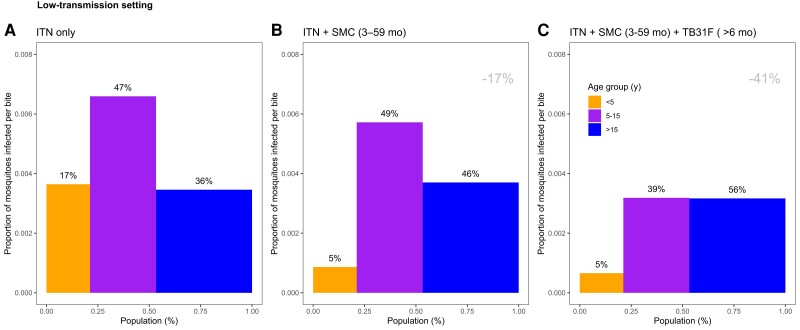Figure 7.
The changing infectious reservoir of malaria in a low-transmission setting, as interventions are introduced. Model-derived projections of how different public health interventions against malaria influence the magnitude and composition of the human infectious reservoir. We show contributions to the infectious reservoir from 3 age groups in a low-transmission setting (based on the Upper River region of the Gambia, as used in Figure 5): children <5 years of age, school-aged children (5–15 y of age), and adults. These contributions are influenced by the average per-person infectivity (y-axes), and the relative sizes of the 3 subpopulations (x-axes). We first assessed the infectious reservoir when the only intervention in use is insecticide-treated nets (A). We then assessed the impact of delivering seasonal malaria chemoprevention (SMC) to 80% of children aged 3–59 mo (B). Third, we measured the impact of delivering TB13F to 80% of school-aged children (C). In this setting, the introduction of TB31F reduces the infectivity in all age groups, due to a reduction in malaria transmission. It also results in a shift in the relative importance of age groups for the infectious reservoir, increasing the contribution that adults make to malaria transmission. The results in each panel were generated by averaging over a 3-year period. A corresponds to a time period prior to the introduction of SMC. B corresponds to the 3-year period (−3, 0) in Figure 4C; C corresponds to the 3-year period (0, 3) in Figure 4C. The percentages above each bar indicates the contribution that each age group makes to the infectious reservoir. The percentage reductions (gray text, top-right corner of B and C) indicate the overall reduction in the infectious reservoir relative to the insecticide-treated net (ITN)–only scenario. To allow a direct comparison between this setting and the high-transmission setting (Figure 6), we use a generic demography for sub-Saharan Africa [21]. In Supplementary Figure 6, we repeat the analysis for the case where TB31F was administered to all age groups. Note that the results presented here are not adjusted for age-dependent biting of mosquitoes.

